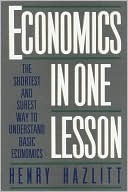More on this book
Community
Kindle Notes & Highlights
Started reading
December 14, 2021
But need is not demand. Effective economic demand requires not merely need but corresponding purchasing power.
Here we shall have to say simply that all government expenditures must eventually be paid out of the proceeds of taxation; that inflation itself is merely a form, and a particularly vicious form, of taxation.
I am here concerned with public works considered as a means of “providing employment” or of adding wealth to the community that it would not otherwise have had.
But a bridge built primarily “to provide employment” is a different kind of bridge. When providing employment becomes the end, need becomes a subordinate consideration. “Projects” have to be invented. Instead of thinking only of where bridges must be built, the government spenders begin to ask themselves where bridges can be built.
Therefore, for every public job created by the bridge project a private job has been destroyed somewhere else.
This is only another way of saying that the government lenders will take risks with other people’s money (the taxpayers’) that private lenders will not take with their own money.
When the government makes loans or subsidies to business, what it does is to tax successful private business in order to support unsuccessful private business.
In brief, on net balance machines, technological improvements, automation, economies and efficiency do not throw men out of work.
Machine save production cost, then more profit for the maker. The maker will buy more mchine to sve more cost which in turn increase the worker needed to make or to run the machine.
in other scenario, the product will be cheaper due to the machine which helps buyer save money to spend in something else. Indirectly incrdease the employment rate in other production line
What machines do, to repeat, is to bring an increase in production and an increase in the standard of living. They may do this in either of two ways. They do it by making goods cheaper for consumers (as in our illustration of the overcoats), or they do it by increasing wages because they increase the productivity of the workers.
The central lesson is that we should try to see all the main consequences of any economic policy or development—the immediate effects on special groups, and the long-run effects on all groups.
Joe lost a job due to a machine. Kate gets a new job contrlling a machine. Alan gets a job making the machine. We need to see everyone and not forget anyone.


